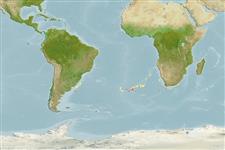>
Scombriformes (Mackerels) >
Trichiuridae (Cutlassfishes) > Aphanopodinae
Etymology: Aphanopus: Greek, aphanes = hidden + Greek, pous = foot (Ref. 45335).
Eponymy: Sergey Vladimirovich Mikhailin (1943–1981) was a Russian ichthyologist at the All-Union Research lnstitute of Marine Fisheries and Oceanography, Moscow. [...] (Ref. 128868), visit book page.
Environment: milieu / climate zone / depth range / distribution range
Ecología
marino bentopelágico; rango de profundidad 905 - 2000 m (Ref. 6181). Deep-water; 23°S - 39°S, 54°W - 84°E (Ref. 6181)
Southeast Atlantic: Namibia and at Walvis Ridge. Southwest Atlantic: off Argentina. Indian Ocean: on seamounts off Mozambique and the West Australian Ridges. Western Pacific: Southeast Australia, North Island in New Zealand and the Challenger Plateau (Ref. 41692).
Tamaño / Peso / Age
Maturity: Lm ? range ? - ? cm
Max length : 90.0 cm TL macho / no sexado; (Ref. 36731)
Espinas dorsales (total) : 42 - 45; Radios blandos dorsales (total) : 61 - 66; Espinas anales: 2; Radios blandos anales: 51 - 57; Vértebra: 111 - 117. Pelvic fins represented by a single spine in juveniles, inserted before the base of the pectoral fins, but entirely absent in adults. Body color is coppery black with iridescent tint. The inside of the mouth and gill cavities black.
Occurs on the continental slope or underwater rises (Ref. 10818).
Life cycle and mating behavior
Madurez | Reproducción | Puesta | Huevos | Fecundidad | Larva
Nakamura, I. and N.V. Parin, 1993. FAO Species Catalogue. Vol. 15. Snake mackerels and cutlassfishes of the world (families Gempylidae and Trichiuridae). An annotated and illustrated catalogue of the snake mackerels, snoeks, escolars, gemfishes, sackfishes, domine, oilfish, cutlassfishes,. scabbardfishes, hairtails, and frostfishes known to date. FAO Fish. Synop. 125(15):136 p. (Ref. 6181)
IUCN Red List Status (Ref. 130435: Version 2024-1)
Threat to humans
Harmless
Human uses
Pesquerías: sin interés
Herramientas
Special reports
Download XML
Fuentes de Internet
Estimates based on models
Preferred temperature (Ref.
123201): 2.5 - 3.1, mean 2.7 °C (based on 61 cells).
Phylogenetic diversity index (Ref.
82804): PD
50 = 0.5078 [Uniqueness, from 0.5 = low to 2.0 = high].
Bayesian length-weight: a=0.00046 (0.00020 - 0.00105), b=3.12 (2.92 - 3.32), in cm total length, based on LWR estimates for this (Sub)family-body shape (Ref.
93245).
Nivel trófico (Ref.
69278): 4.1 ±0.7 se; based on size and trophs of closest relatives
Resiliencia (Ref.
120179): Bajo, población duplicada en un tiempo mínimo de 4.5-14 años (Assuming tmax>10).
Fishing Vulnerability (Ref.
59153): High vulnerability (56 of 100).
